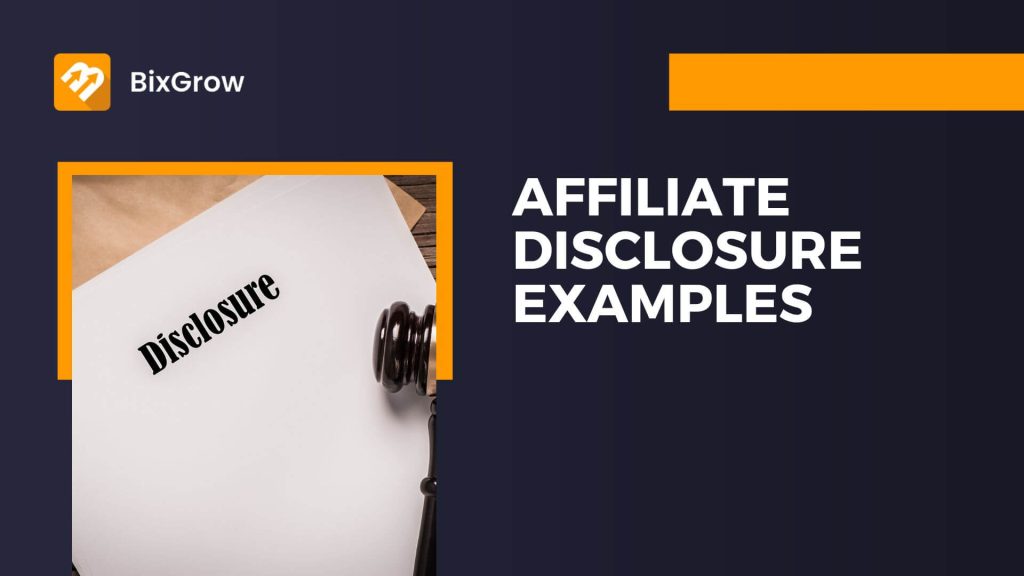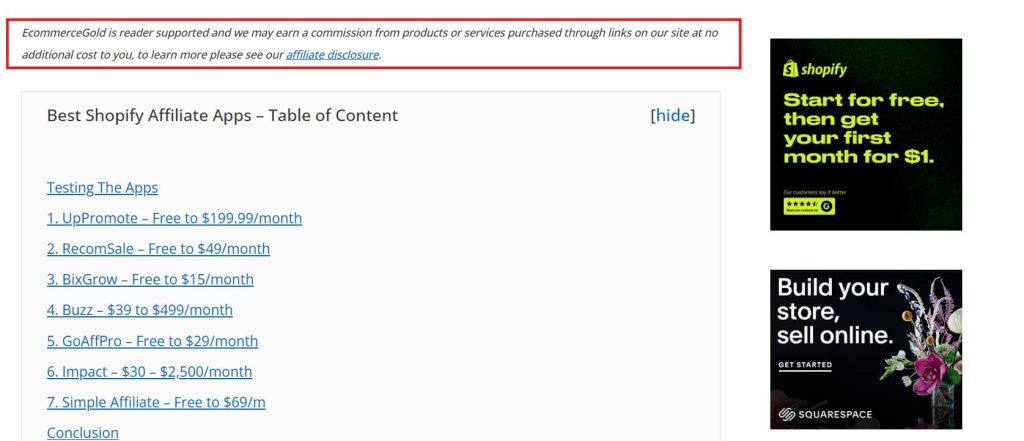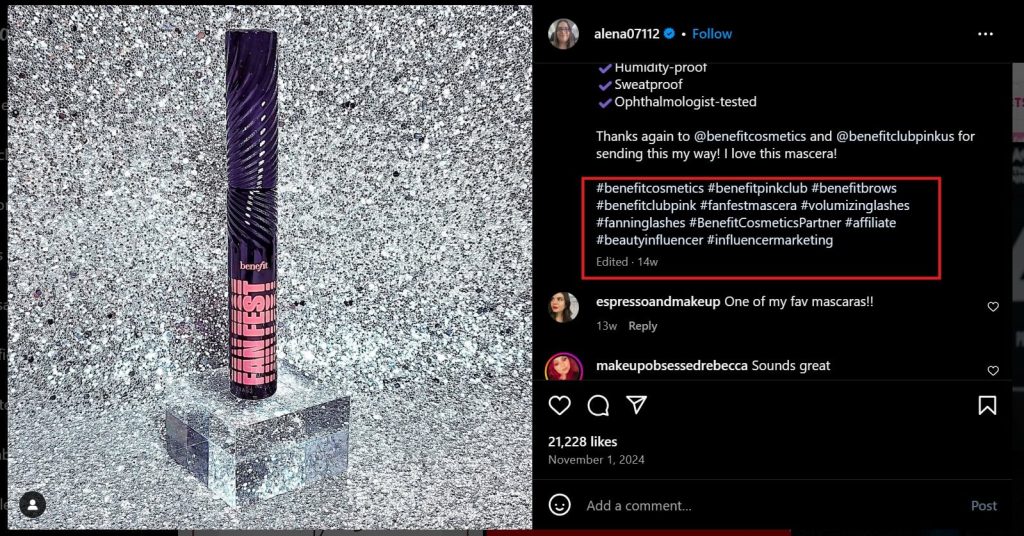Affiliate marketing is one of the most effective ways to monetize content, with spending on affiliate marketing projected to surpass $13 billion globally by 2025. Transparency is key in affiliate marketing, and that’s where affiliate link disclosures come into play.
Affiliate link disclosures are not just a best practice, they’re a legal requirement. If you do not disclose affiliate relationship, it can lead to hefty penalties, damaged credibility, and loss of trust from your audience.
In this guide, we’ll explore everything you need to know about affiliate link disclosures.

What is affiliate link disclosure?
Affiliate link disclosure is a statement that informs your audience about your relationship with the products or services you promote through affiliate links. It’s an essential practice that ensures transparency, maintains trust, and complies with legal requirements.
An affiliate disclosure clearly communicates to users that you earn a commission if they purchase through your link. For example, it might say: “This post contains affiliate links. If you purchase through these links, I may earn a small commission at no extra cost to you”
The key standard of affiliate disclosure statement:
- Clarity and simplicity: Avoid vague or confusing language. The disclosure should be easy for all audiences to understand. Avoid using phrases like “I may be compensated” without further explanation. Instead, directly state that you earn commissions from affiliate links.
- Placement in prominent locations: For blog posts, include the disclosure at the beginning of the content or directly before the first affiliate link. For social media posts, it should be visible in captions or using hashtags like #Ad or #Affiliate. For video content, mention the disclosure verbally and include it in the video description or overlay text.
In many countries, including the United States, the Federal Trade Commission (FTC) requires affiliate disclosures to be conspicuous and transparent. Similarly, the European Union mandates disclosures under GDPR rules. Failing to include proper disclosures can lead to fines or legal action.
Penalty for not disclosing affiliate links
Failing to add an affiliate link disclaimer isn’t just an ethical misstep, it’s a legal violation that can lead to severe consequences. Governments and regulatory bodies worldwide are taking increasing action to ensure compliance with transparency standards in online marketing.
Legal penalties and fines
Affiliates can face legal penalties and fines if they violate laws while promoting products, either in their own location or in the region where they are marketing. The legal risks depend on:
- Where the affiliate is based – They must comply with the regulations of their home country.
- Where their audience is located – They must follow the laws of the region where they are promoting.
Two big market often targeted by affiliates, U.S and E.U, have its own regulations.
Federal Trade Commission (FTC) penalties: In the United States, the FTC enforces strict disclosure requirements for affiliate marketers. Violations can lead to significant fines. For instance, in 2016, the FTC charged Warner Bros. $250,000 for failing to disclose that they paid influencers to promote the video game Middle-earth: Shadow of Mordor.
European Union Fines under GDPR: The EU’s General Data Protection Regulation (GDPR) mandates transparency in online promotions. Non-compliance can result in fines of up to €20 million or 4% of global turnover, whichever is higher. This includes failing to disclose affiliate relationships.
Loss of audience trust
Studies have shown that 86% of consumers value transparency from brands, with 73% willing to pay more for products that come from honest companies. Not disclosing affiliate relationships risks eroding trust, which can hurt long-term audience engagement and profitability.
Risk to affiliate accounts
Platforms like Amazon Associates and other affiliate networks require strict adherence to their terms of service, which include proper disclosure. Non-compliance can result in account suspension or termination and loss of earnings.
Increased regulatory monitoring
As digital marketing grows, regulators worldwide are scrutinizing disclosures more closely. The UK’s Competition and Markets Authority (CMA) has issued warnings to influencers and affiliate marketers about proper disclosure. Australia’s ACCC has also issued fines for misleading online promotions.
How to disclose affiliate links? Affiliate link disclosure examples?
To comply with regulations and maintain transparency with your audience, it’s crucial to tailor your affiliate link disclosure to the platform you’re using. Let’s look at practical affiliate disclaimer examples:
On blogs & websites

When including affiliate links in blog posts or web content, ensure the disclosure is clearly visible to the reader.
- In-text disclosure: Add a short disclaimer near the affiliate link. An Amazon affiliate disclaimer example is “This post contains affiliate links, which means we may earn a small commission if you purchase through these links – at no extra cost to you.”
- Prominent placement: Place a general disclosure at the top of the article or page. You can add the disclosure in the footer or sidebar too.
On social media (Facebook, Instagram, etc.)

When posting affiliate links on social media, disclosures should be concise and blend naturally into the content.
- Post caption: “Check out my favorite skincare products here [affiliate link]! #Ad #Affiliate”
- Hashtags: Use clear hashtags like #Ad, #Affiliate, or #Sponsored in every promotional post.
- Story disclosures: On platforms like Instagram Stories, include text overlays such as “This post contains affiliate links” or “Affiliate Link” with the swipe-up feature.
On TikTok
Given TikTok’s visual nature, clear and engaging disclosures can build trust.
- In-video: Add a verbal disclosure, such as: “This product was recommended through an affiliate link”
- Text overlay: Include a short text on-screen, such as: “Affiliate Link” or “I earn commissions from purchases.”
- Caption hashtags: Similar to other platforms, include #Affiliate, #Ad, or #Commission in your captions.
On YouTube
Video disclosures are an essential part of affiliate marketing on YouTube:
- Verbal acknowledgment: Include a spoken statement in the video. Example: “This video contains affiliate links, and I earn a small commission if you make a purchase.”
- Video description: Add a written disclosure near the top of the description box, a FTC-approved affiliate disclosure example is “Some links in this description are affiliate links, meaning we earn a commission at no additional cost to you.”
Paid ads
When running paid ads as part of your affiliate marketing strategy, transparency is key. Even when affiliates just run ads, you must disclose the relationship to ensure consumer trust and comply with advertising laws like the FTC’s endorsement guidelines.
There are some ways to disclose affiliate relationship when you run paid ads, including in-ads disclosure,
#1. Include disclosure in ad copy
It’s essential to make your affiliate relationship clear within the ad itself. Whether running Google Ads, Facebook Ads, or TikTok promotions, the disclosure must be part of the ad text.
Some free affiliate disclaimer templates for your ads:
Google Ads:
- Headline: “Top Fitness Gear (Affiliate Link)”
- Description: “Shop now through this affiliate link. Support our work!”
Social Media Ads (Facebook/Instagram):
- Caption: “Love this product? Check it out here! #Affiliate #Ad”
- Text Overlay (for images/videos): “This link earns us a small commission.”
#2. Use disclosures on the landing page
If your ad links directly to a landing or product page, including a disclosure on that page ensures continued transparency.
- Pop-up or banner: “Disclosure: This page contains affiliate links. We earn a commission if you purchase through these links.”
- Static text above the fold: Place the disclosure prominently where users don’t have to scroll to see it.
#3. Adapt to different advertising platforms
Each platform has specific requirements for running ads with affiliate links. Follow these guidelines to ensure compliance:
Google Ads:
- Direct linking to affiliate links is generally prohibited unless they comply with strict advertising policies.
- Best practice: Use a landing page with a clear affiliate disclosure instead of linking directly to the affiliate URL.
Facebook/Instagram Ads: Include disclosures in the ad copy, captions, or hashtags like #Ad, #Affiliate, or #Sponsored. Add text overlays for visual content.
TikTok Ads: Include verbal or written disclosures in the video (e.g., “This link is an affiliate link”). Add text-based disclosures in the caption or description, and use hashtags like #Affiliate or #Ad.
#4. Use tools to simplify disclosure
Streamline the process of adding disclosures to your ads with tools that simplify affiliate management:
- Affiliate Link Cloakers: Use tools like Pretty Links or Bitly to create user-friendly, clearly labeled affiliate links (e.g., affiliatename.com/product).
- Plugins for Landing Pages: Use plugins or widgets to automatically include disclaimers on landing pages.
FAQs on affiliate link disclosures
Can I just say “sponsored” instead of “affiliate”?
Where should I place affiliate disclosures?
– For blog posts, the disclosure should be visible at the beginning of the post or in a prominent spot before the affiliate link appears.
– For social media, mention the disclosure in the caption or use hashtags like #Ad, #Affiliate, #sponsored.
– On YouTube, include the disclosure both in the video description and, if possible, within the video itself.
Can I use affiliate link cloaking to avoid disclosing links?
Do I need to disclose affiliate links in email marketing?
Conclusion
Affiliate marketing offers a lucrative opportunity for influencers, content creators, and businesses to earn commissions through product promotions. However, the key to maintaining trust with your audience and staying compliant with advertising laws lies in clear and transparent affiliate link disclosure. By following proper disclosure guidelines, whether it’s on your blog, social media posts, TikTok videos, or paid ads, you are not only building credibility but also avoiding potential legal risks.
Start implementing these best practices today to foster trust, stay compliant, and grow your affiliate marketing efforts with confidence